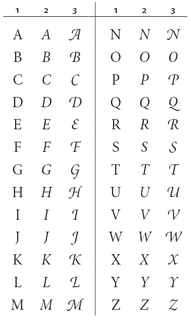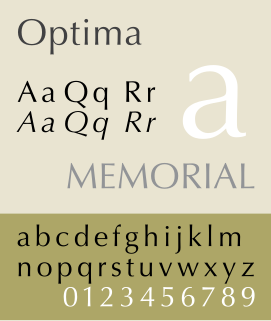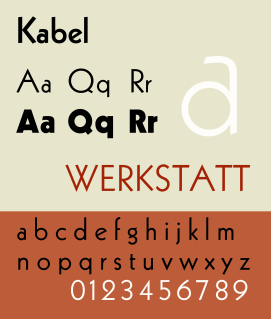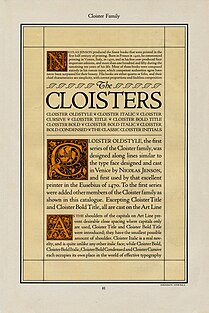 | |
| Category | Serif Display |
|---|---|
| Designer(s) | Gudrun Zapf-von Hesse |
| Foundry | Stempel Linotype |
| Date released | c. 1951 |
Diotima is a serif typeface designed by Gudrun Zapf-von Hesse and published by Stempel. [lower-alpha 1] [1]
In typography, a serif is a small line or stroke regularly attached to the end of a larger stroke in a letter or symbol within a particular font or family of fonts. A typeface or "font family" making use of serifs is called a serif typeface, and a typeface that does not include them is a sans-serif one. Some typography sources refer to sans-serif typefaces as "grotesque" or "Gothic", and serif typefaces as "roman".

In typography, a typeface is a set of one or more fonts each composed of glyphs that share common design features. Each font of a typeface has a specific weight, style, condensation, width, slant, italicization, ornamentation, and designer or foundry. For example, "ITC Garamond Bold Condensed Italic" means the bold, condensed-width, italic version of ITC Garamond. It is a different font from "ITC Garamond Condensed Italic" and "ITC Garamond Bold Condensed", but all are fonts within the same typeface, "ITC Garamond". ITC Garamond is a different typeface from "Adobe Garamond" or "Monotype Garamond". There are thousands of different typefaces in existence, with new ones being developed constantly.
Gudrun Zapf von Hesse is a German typographer, calligrapher and book-binder. She is the 1991 winner of the Frederic W. Goudy Award. She has also designed several fonts.
Contents
Diotima has a relatively slender and wide design, light in colour and suitable for purposes such as decorative printing and headings rather than for body text. [2] [3] [4] Aspects of the roman recall Roman square capitals such as those on the Column of Trajan, such as the 'M' with no upper serifs (it has serifs in italic). The italic lower-case is relatively calligraphic in design with a 'single-story' 'g'. The design is named for the philosopher Diotima of Mantinea, perhaps appropriately highlighting its status as one of the few typefaces designed by a woman up to this point.

Type color is an element of typography that describes how dense or heavy the text appears on the page. Finding the correct balance of type color and white space can make text more easily readable. The term type color should not be confused with the usual meaning of color,, instead it has more to do with the blackness or boldness of the text on the page. A bold font creates more contrast on the page, therefore creates more emphasis. Using a bold font is therefore one way that type color can be adjusted.

Roman square capitals, also called capitalis monumentalis, inscriptional capitals, elegant capitals and capitalis quadrata, are an ancient Roman form of writing, and the basis for modern capital letters.

In typography, italic type is a cursive font based on a stylized form of calligraphic handwriting. Owing to the influence from calligraphy, italics normally slant slightly to the right. Italics are a way to emphasise key points in a printed text, to identify many types of creative works, or, when quoting a speaker, a way to show which words they stressed. One manual of English usage described italics as "the print equivalent of underlining".
Diotima was released in the roman or regular style around 1951 and the italic around 1953, although Zapf-von Hesse had been working on the design for some years by this point. [5] [6] [7] The design was her first full typeface. [8] Her husband, Hermann Zapf, used it for typesetting their wedding announcement. [9]

In Latin script typography, roman is one of the three main kinds of historical type, alongside blackletter and italic. Roman type was modelled from a European scribal manuscript style of the 15th century, based on the pairing of inscriptional capitals used in ancient Rome with Carolingian minuscules developed in the Holy Roman Empire.

Hermann Zapf was a German type designer and calligrapher who lived in Darmstadt, Germany. He was married to the calligrapher and typeface designer Gudrun Zapf-von Hesse. Typefaces he designed include Palatino, Optima and Zapfino.
As was common for work by Stempel at this time, the original release was crafted by the punchcutter August Rosenberger. Stempel later released Ariadne-Initialen (Ariadne Initials), a set of swash capitals to complement it. The design was later reissued by Linotype.

Punchcutting is a craft used in traditional typography to cut letter punches in steel as the first stage of making metal type. Steel punches in the shape of the letter would be used to stamp matrices into copper, which were locked into a mould shape to cast type. Cutting punches and casting type was the first step of traditional typesetting. The cutting of letter punches was a highly skilled craft requiring much patience and practice. Often the designer of the type would not be personally involved in the cutting.

A swash is a typographical flourish, such as an exaggerated serif, terminal, tail, entry stroke, etc., on a glyph. The use of swash characters dates back to at least the 16th century, as they can be seen in Ludovico Vicentino degli Arrighi's La Operina, which is dated 1522. As with italic type in general, they were inspired by the conventions of period handwriting. Arrighi's designs influenced designers in Italy and particularly in France.

The Mergenthaler Linotype Company is a corporation founded in the United States in 1886 to market the Linotype machine, a system to cast metal type in lines (linecaster) invented by Ottmar Mergenthaler. It became the world's leading manufacturer of book and newspaper typesetting equipment; outside North America, its only serious challenger for book production was the Anglo-American Monotype Corporation. It also offered phototypesetting and digital products before being taken over by Monotype Imaging in 2006.
In 2001, San Francisco Public Library held an exhibition on Hermann and Gudrun Zapf's work, showcasing early specimens of Diotima. [10]

The San Francisco Public Library is the public library system of the city of San Francisco. The Main Library is located at Civic Center, at 100 Larkin Street. The library system has won several awards, such as Library Journal's Library of the Year award in 2018. The library is well-funded due to the city's dedicated Library Preservation Fund that was established by a 1994 ballot measure, which was subsequently renewed until 2022 by a ballot measure in 2007.















